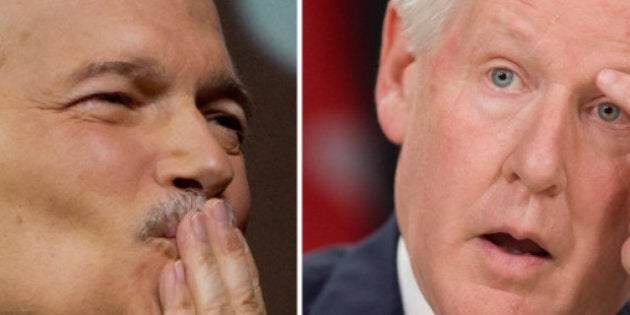
To merge or not to merge, that is the question.
At first glance, a merger of the New Democratic and Liberal parties might seem like the only way to defeat a Conservative majority government, but things are rarely so simple.
If the past is any guide, an NDP/Liberal merger would likely lead to one more Tory term.
Over the weekend, delegates at the NDP’s convention in Vancouver voted against a proposal to ban any merger talks between their party and the Liberals. Though no such talks appear to be underway and both parties have publicly resolved to continue operating separately, the NDP has left the door open to a merger of the opposition.
A combination of Liberal and NDP votes in the past election would have delivered 186 seats to the merged parties, an easy majority. But it is extremely unlikely that the new party could retain every single NDP and Liberal voter.
Indeed, in an Environics post-election survey only 21 per cent of Liberal voters supported the idea of a merger.
With the formation of a Liberal-New Democratic party, many Liberal voters would head elsewhere.
In B.C. and Alberta, the two provinces in which the Greens took their highest share of the vote in the country, it can be expected that a good number of Liberals would head to the fiscally centrist environmental party. Another good chunk would likely turn to the Conservatives, whose predecessor parties (the Progressive Conservatives and the Canadian Alliance) earned 57 per cent of the vote in B.C. in 2000.
In the rest of English Canada, the Liberal-New Democrats might have a better shot of retaining the vote of their former parties. In the last election, voters flocked to the NDP when they appeared to be the leading alternative to the Tories. And Liberal voters were more likely than any others to cast their ballot because of their local candidate, who would likely still run in a merged party.
But in Quebec, the Liberal-New Democrats might have some real difficulty. In francophone Quebec, the new party, weighed down by its history of the sponsorship scandal, would likely turn off many of the NDP’s new voters who were looking for change. The possibility of being represented by an even more national party than the current NDP could also turn away many former Bloc supporters, while Liberal voters outside of Montreal could turn to the Conservatives.
Taking together all of these factors and portioning out the vote using the University of British Columbia’s election forecaster, we end up with a result of about 180 seats for the Conservatives, 120 for the Liberal-New Democrats, and 10 for the Bloc Québécois, give or take a few seats.
In fact, this forecaster indicates that at least 79 per cent of former Liberal voters would have to vote for the new merged party in order to overturn the last election’s results and oust the Conservatives from power.
Considering that in 2004 only about 40 per cent former Progressive Conservative voters went over to the new, Canadian Alliance-dominated Conservatives, the odds are stacked against a merged Liberal-NDP party winning the next election in 2015.
But 2019? That’s another story.
Éric Grenier taps the pulse of federal and regional politics for Huffington Post Canada readers on Tuesdays and Fridays. Grenier is the author of ThreeHundredEight.com, covering Canadian politics, polls and electoral projections.